Lesser-known province to cultivate rural tourism

TEHRAN – Chaharmahal-Bakhtiari, a lesser-known travel destination in southwest Iran, seeks to expand its rural tourism in close collaboration with private investors.
The expansion of rural tourism is high on the agenda, the provincial tourism chief Morteza Mohammadian Dehkordi said on Sunday.
Chaharmahal-Bakhtiari embraces more than 900 villages, each having considerable potential in terms of natural and cultural, the official stated.
“In that regard, we are preparing the ground for the growth of rural tourism in the province that offers visitors over 800 travel attractions.”
“To gain the needed tourism infrastructure, we are negotiating with the private sector to formulate investment packages,” the official explained.
An off-the-beaten-path tourist destination, Chaharmahal-Bakhtiari, is the birthplace of various unique traditions and rituals relative to the 'tribal' lifestyles.
Experts say the province has considerable potential to become a vibrant tourist attraction because of its changing natural landscape.
Nowadays, an increasing number of travelers are looking for something different, such as spending a day in the tranquil countryside, picking fresh fruits, watching rice grow, fishing by the seaside, eating traditional dishes or even staying with locals.
To put it in other words, many urban residents tend to choose rural tourism to enjoy a slow-paced lifestyle that resembles something like ‘the Internet + countryside.’
To put it another way, a lot of urban dwellers favor rural travel to take advantage of a relaxed way of life similar to "the Internet countryside."
In contrast, traditional forms of transportation are typically booked through travel agencies. As tourists get older, more and more types of travel are welcomed by those looking for undiscovered destinations.
Iran has a lot to offer nature lovers who appreciate pristine, diverse natural resources. The World Tourism Organization (UNWTO) is expected to award the title of "Best Tourism Villages" to many rural locations around the world, and the villages of Kharanaq, Barandaq, and Lark have been nominated.
UNWTO sees rural tourism as a type of activity in which the visitor’s experience is related to a wide range of products generally linked to nature-based activities, agriculture, rural lifestyle, culture, angling, and sightseeing. Such tourism also possesses characteristics such as low population density, a landscape dominated by agriculture and forestry, as well as traditional social structure and lifestyle.
The UN body aims to turn the spotlight on the “uniqueness” of each village to make tourism a means for further development in rural areas. “We want to recognize the uniqueness of each village and showcase the best initiatives to make tourism a means for a better future in rural areas. As we restart tourism, we work to ensure that we leave no one - and no village- behind,” according to UNWTO Secretary-General Zurab Pololikashvili.
Needless to say that the growth of the local economy is the ultimate goal of the rise and development of the rural tourism industry, but in the long run, to enable the long-term development of the rural tourism industry, the health maintenance and growth of environmental capacity is very important.
Consequently, rural tourism is not a magic solution to the problems faced by many rural areas, but it opens up opportunities for economic progress, social and cultural development, and enhancing people’s togetherness.
AFM
Leave a Comment